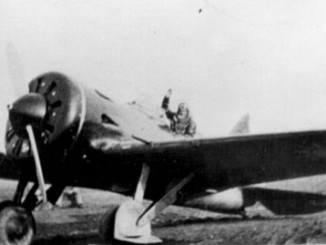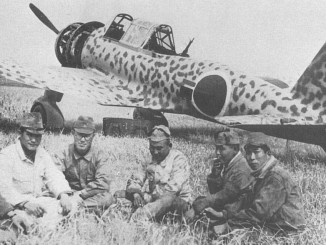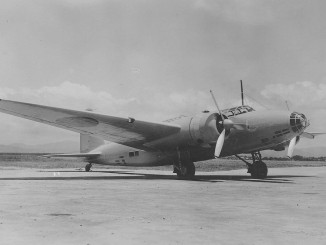
The Mitsubishi A6M was designed by the legendary aircraft engineer Jiro Hirokoshi in response to the Japanese’s Navy’s 12-Shi requirement for a new carrier fighter to replace the A5M Type 96. The request called for a speed of 370mph, an endurance of 8 hours, a pair of 20mm cannon, and manoeuvrability at least equal to the A5M. Nakajima were also invited to submit a proposal, but pulled out citing unachievable requirements. Hirokoshi’s team produced a winning design which was designated the Type 0 Carrier Fighter, commonly known as the ‘Reisen’ or ‘Zero-Fighter’ in Japanese and the ‘Zero’ to the Allies.
The A6M achieved its excellent manoeuvrability by having a very low wing loading, coupled with large control surfaces. The airframe was largely constructed of new extremely light duralumin, but featured no armour or bulletproof protection for the pilot, and no self-sealing fuel tanks. This helped the Zero to maintain its nimbleness and range, but would prove deadly to hundreds of pilots during the war. It was powered by a Nakajima Sakae engine which produced 1,000hp, low by Western standards but enough to propel the fighter to over 300mph. The Zero was usually seen with a 330 litre drop tank under the belly to provide the necessary endurance.
The A6M made its combat debut over China, escorting bombers to Chungking and Chengtu, quickly destroying the remnants of the Chinese Air Force. The type flew from all 6 of the carriers assigned to the Pearl Harbor operation, and during the first stages of the war over the Philippines and the Dutch East indies it swept the skies of Allied fighters. The Zero then featured in the carrier battles of 1942 and the Guadalcanal campaign, where it came up against the F4F Wildcat using ‘Tach Weave’ tactics to counter the superior agility of the Japanese fighter.
By 1943 the tide had begun to turn for the Zero, as many of the best pilots had been killed during the previous year’s battles and the USN and USAAF were introducing better aircraft like the F4U Corsair, F6F Hellcat and P-38 Lighting. Unfortunately the Japanese were unable to produce a viable replacement so the Zero soldiered on until the end of the war, suffering tremendous losses but still proving to be a dangerous adversary in the hands of one of the few remaining skilled pilots in the IJN. Zeros were commonly used in the kamikaze role throughout the last year of the war.
In 1942 the Zero was assigned the Allied Reporting Name ‘Zeke’ by Capt Frank T. McCoy, who was inspired to choose the hillbilly name as a tribute to his Southern roots. The square-winged A6M3 Model 32 was initially assigned the codename ‘Hap’ as a tribute to General Henry H. ‘Hap’ Arnold, chief of the Army Air Force, but he objected to this so the codename was quickly changed to ‘Hamp’ instead.
Mitsubishi A6M Type 0 Specifications
| Mitsubishi A6M1 | |
| Role | Carrier Fighter |
| Crew | 1 |
| Powerplant | 1x Mitsubishi Zuisei 13 (950hp) |
| Speed | 316mph (max) |
| Ceiling | 32,810ft |
| Range | 1,160 miles (internal) 1,929 miles (external) |
| Armament | 2x Type 97 7.7mm Machine Gun 2x Type 99 20mm Cannon |
| Ordnance | 265lb bombs |
| Dimensions | 29ft 9in (length) 39ft 4in (wingspan) 11ft 6in (height) |
| Wing Area | 242 sq.ft. |
| Weight | 3,642lb (empty) 5,165lb (gross) |
| Number produced | 3 |
| Mitsubishi A6M2 Model 11 | |
| Role | Carrier Fighter |
| Crew | 1 |
| Powerplant | 1x Nakajima Sakae 12 (975hp) |
| Speed | 207mph (cruise) 331mph (max) |
| Ceiling | 33,000ft |
| Range | 1,160 miles (internal) 1,929 miles (external) |
| Armament | 2x Type 97 7.7mm Machine Gun 2x Type 99 20mm Cannon |
| Ordnance | 265lb bombs |
| Dimensions | 29ft 9in (length) 39ft 4in (wingspan) 11ft 6in (height) |
| Wing Area | 242 sq.ft. |
| Weight | 3,704lb (empty) 5,313lb (gross) 6,164lb (max) |
| Number produced | 64 |
| Mitsubishi A6M2 Model 21 | |
| Role | Fighter |
| Crew | 1 |
| Powerplant | x Nakajima Sakae 12 (975hp) |
| Speed | 207mph (cruise) 331mph (max) |
| Ceiling | 33,000ft |
| Range | 1,160 miles (internal) 1,927 miles (external) |
| Armament | 2x Type 97 7.7mm Machine Gun 2x Type 99 20mm Cannon |
| Ordnance | 265lb bombs |
| Dimensions | 29ft 9in (length) 39ft 4in (wingspan) 10ft 0in (height) |
| Wing Area | 242 sq.ft. |
| Weight | 3,704lb (empty) 6,164lb (gross) 6,164lb (max) |
| Number produced | 1,552 |
| Mitsubishi A6M2-N | |
| Role | Fighter Seaplane |
| Crew | 1 |
| Powerplant | 1x Nakajima Sakae 12 (975hp) |
| Speed | 184mph (cruise) 271mph (max) |
| Ceiling | 32,810ft |
| Range | 714 miles (internal) 1,107 miles (external) |
| Armament | 2x Type 97 7.7mm Machine Gun 2x Type 99 20mm Cannon |
| Ordnance | 265lb bombs |
| Dimensions | 33ft 1in (length) 39ft 4in (wingspan) 14ft 1in (height) |
| Wing Area | 242 sq.ft. |
| Weight | 4,235lb (empty) 5,423lb (gross) 6,349lb (max) |
| Number produced | 327 |
| Mitsubishi A6M3 Model 22 | |
| Role | Carrier Fighter |
| Crew | 1 |
| Powerplant | 1x Nakajima Sakae 21 (1,130hp) |
| Speed | 338mph (max) |
| Ceiling | 33,000ft |
| Range | 1,477 miles (external) |
| Armament | 2x Type 97 7.7mm Machine Gun 2x Type 99 20mm Cannon |
| Ordnance | 265lb bombs |
| Dimensions | 29ft 9in (length) 36ft 1in (wingspan) 11ft 6in (height) |
| Wing Area | 232 sq.ft. |
| Weight | 3,984lb (empty) 5,609lb (gross) |
| Number produced | 560 |
| Mitsubishi A6M5 Model 52 | |
| Role | Carrier Fighter |
| Crew | 1 |
| Powerplant | 1x Nakajima Sakae 21 (1,130hp) |
| Speed | 230mph (cruise) 351mph (max) |
| Ceiling | 38,520ft |
| Range | 1,171 miles (internal) |
| Armament | 2x Type 97 7.7mm Machine Gun 2x Type 99 20mm Cannon |
| Ordnance | 265lb bombs |
| Dimensions | 29ft 11in (length) 36ft 1in (wingspan) 11ft 6in (height) |
| Wing Area | 230 sq.ft. |
| Weight | 4,136lb (empty) 6,510lb (max) |
| Number produced | 747 |
| Mitsubishi A6M5a | |
| Role | Fighter |
| Crew | 1 |
| Powerplant | 1x Nakajima Sakae 21 (1,130hp) |
| Speed | 348mph (max) |
| Ceiling | 38,520ft |
| Range | 1,194 miles (internal) |
| Armament | 2x Type 97 7.7mm Machine Gun 2x Type 99 20mm Cannon |
| Ordnance | |
| Dimensions | 0ft 0in (length) 0ft 0in (wingspan) 0ft 0in (height) |
| Weight | |
| Number produced | 391 |
| Mitsubishi A6M7 | |
| Role | Carrier Fighter |
| Crew | 1 |
| Powerplant | 1x Nakajima Sakae 31 (1,210hp) |
| Speed | |
| Ceiling | 0ft |
| Range | |
| Armament | 2x Type 99 20mm Cannon 3x Type 3 13.2mm Machine Gun |
| Ordnance | |
| Dimensions | 29ft 11in (length) 36ft 1in (wingspan) 11ft 6in (height) |
| Wing Area | 229 sq.ft. |
| Weight | 6,495lb (gross) |




Leave a Reply